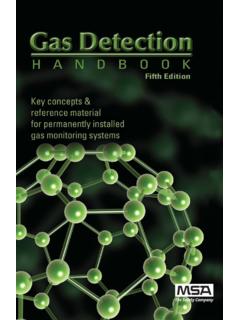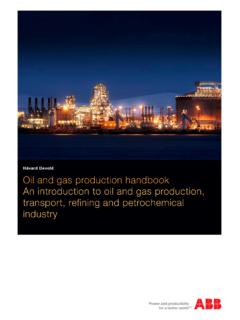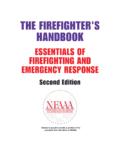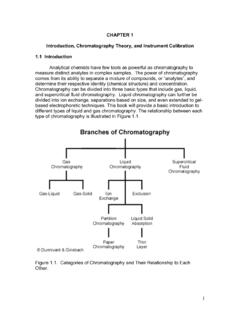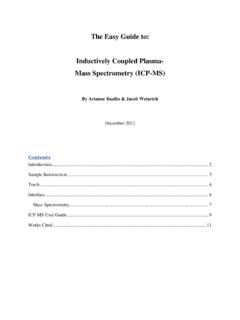Transcription of LANGE'S HANDBOOK OF CHEMISTRY
1 LANGE'S HANDBOOK OF CHEMISTRY John A. Dean Professor Emeritus of CHEMISTRY University of Tennessee, Knoxville Fifteenth Edition McGRAW-HILL, INC. New York St. Louis San Francisco Auckland Bogot Caracus Lisbon London Madrid Mexico Milan Montreal New Delhi Paris San Juan S o Paulo Singapore Sydney Tokyo Toronto Copyright 1999, 1992, 1985, 1979, 1973, 1967, 1961, 1956 by McGraw- Hill, Inc. All rights reserved. Copyright renewed 1972 by Norbert Adolph Lange. Copyright 1952, 1949, 1946, 1944, 1941, 1939, 1937, 1934 by McGraw-Hill, Inc. All rights reserved. Printed in the United States of America. Except as permitted under the United States Copyright Act of 1976, no part of this publication may be reproduced or distributed in any form or by any means, or stored in a data base retrieval system without the prior written permis- sion of the publisher.
2 5 6 7 8 9 0 DOC/DOC 9 0 3 2 1 0 9 8 ISBN 0-07-016384-7 The sponsoring editor for this book was Robert Esposito, and the production supervisor was Clare B. Stanley. It was set in Times Roman by Progressive Information Technologies. Printed and bound by R. R. Donnelley & Sons Company. Information contained in this work has been obtained by McGraw- Hill, Inc., from sources believed to be reliable. However, neither McGraw-Hill nor its authors guarantee the accuracy or completeness of any information published herein and neither McGraw-Hill nor its authors shall be responsible for any errors, omissions, or damages arising out of use of this information. This work is published with the understanding that McGraw-Hill and its authors are supplying infor- mation but are not attempting to render engineering or other profes-sional services.
3 If such services are required, the assistance of an appropriate profession should be sought. Grateful acknowledgment is hereby made of an indebtedness to those who have contributed toprevious editions and whose compilations continue in use in this edition. In particular, acknowledg-ment is made of the contribution of L. P. Buseth, who prepared the conversion tables for the thirteenthedition and who prepared the table on the Standard Sieve THE EDITORJohn A. Dean assumed the editorship of LANGE'S HANDBOOK of CHEMISTRY in 1968 withthe Eleventh Edition. He is currently Professor Emeritus of CHEMISTRY at the Universityof Tennessee at Knoxville. The author of nine major CHEMISTRY reference books usedthroughout the world, John Dean's research interests, reflected in over 105 researchpapers and scholarly publications, include instrumental methods of analysis, flame emis-sion and atomic absorption spectroscopy, chromatographic and solvent extraction meth-ods, and polarography.
4 He received his , , and in CHEMISTRY from theUniversity of Michigan at Ann Arbor. In 1974, he was given the Charles H. Stone Awardby the Carolina-Piedmont Section of the American Chemical Society. In 1991, he wasawarded the Distinguished Service Award by the Society for Applied Spectroscopy; bythe same organization he was awarded Honorary Membership in TOFIFTEENTH EDITIONThis new edition, the fifth under the aegis of the present editor, remains the one-volumesource of factual information for chemists, both professionals and students the first placein which to look it up on the spot. The aim is to provide sufficient data to satisfy allone s general needs without recourse to other reference sources. A user will find thisvolume of value as a time-save rbecause of the many tables of nume rical data which havebeen especially properties for a basic group of approximately 4300 organic compounds arecompiled in Section 1, an increase of 300 entries.
5 All entries are listed alphabeticallyaccording to the senior prefix of the name. The data for each organic compound include(where available) name, structural formula, formula weight, Beilstein reference (or if un-available, the entry to theMerck Index,12th ed.), density, refractive index, melting point,boiling point, flash point, and solubility (citing numerical values if known) in water andvarious common organic solvents. Structural formulas either too complex or too ambig-uous to be rendered as line formulas are grouped at the bottom of each facing double pageon which the entries appear. Alternative names, as well as trivial names of long-standingusage, are listed in their respective alphabetical order at the bottom of each double pagein the regular alphabetical sequence. Another feature that assists the user in locating adesired entry is the empirical formula 2 on General Information, Conversion Tables, and Mathematics has had thetable on general conversion factors thoroughly reworked.
6 Similarly the material on Statis-tics in Chemical Analysis has had its contents more than properties for a basic group of inorganic compounds are compiled in Section3, which has undergone a small increase in the number of entries. Many entries under thecolumn Solubility supply the reader with precise quantities dissolved in a stated solventand at a given portions of Section 4, Properties of Atoms, Radicals, and Bonds, have beensignificantly enlarged. For example, the entries under Ionization Energy of Molecularand Radical Species now numbe r740 and have an additional column with the enthalpyof formation of the ions. Likewise, the table on Electron Affinities of the Elements,Molecules, and Radicals now contains about 225 entries. The Table of Nuclides hasmaterial on additional radionuclides, their radiations, and the neutron capture cross material for Section 5 includes the material on surface tension, viscosity, di-electric constant, and dipole moment for organic compounds.
7 In order to include moredata at several temperatures, the material has been divided into two separate tables. Ma-terial on surface tension and viscosity constitute the first table with 715 entries; includedis the temperature range of the liquid phase. Material on dielectric constant and dipoleDEAN #37261 (McGHP)RIGHTINTERACTIVEtop of pageviibase of DFshortstandardviiiPREFACE TO FIFTEENTH EDITION moment constitute another table of 1220 entries. The additional data at two or more tem-peratures permit interpolation for intermediate temperatures and also permit limited ex-trapolation of the data. The Properties of Combustible Mixtures in Air has been revisedand expanded to include ove r450 compounds. Flash points a re to be found in Section revised are the tables on Thermal Conductivity for gases, liquids, and de rWaals constants fo rgases has been b rought up to date and expanded to ove 6, which includes Enthalpies and Gibbs Energies of Formation, Entropies, andHeat Capacities of Organic and Inorganic Compounds, and Heats of Melting, Vaporization,and Sublimation and Specific Heat at Various Temperatures for organic and inorganiccompounds, has expanded by 11 pages, but the majo radditions have involved data incolumns where it previously was absent.
8 More material has also been included for criticaltemperature, critical pressure, and critical section on Spectroscopy has been retained but with some revisions and section includes ultraviolet-visible spectroscopy, fluorescence, infrared and Ramanspectroscopy, and X-ray spectrometry. detection limits are listed for the elements whenusing flame emission, flame atomic absorption, electrothermal atomic absorption, argoninduction coupled plasma, and flame atomic fluorescence. Nuclear magnetic resonanceembraces tables for the nuclear properties of the elements, proton chemical shifts andcoupling constants, and similar material for carbon-13, boron-11, nitrogen-15, fluorine-19, silicon-19, and Section 8, the material on solubility constants has been doubled to 550 on proton transfer reactions, including some at various temperatures, formationconstants of metal complexes with organic and inorganic ligands, buffer solutions of alltypes, reference electrodes, indicators, and electrode potentials are retained with somerevisions.
9 The material on conductances has been revised and expanded, particularly inthe table on limiting equivalent ionic in Sections 9 and 10 on physiochemical relationships, and on polymers,rubbers, fats, oils, and waxes, respectively, has been 11, Practical Laboratory Information, has undergone significant changes andexpansion. Entries in the table on Molecular Elevation of the Boiling Point have beenincreased. McReynolds constants for stationary phases in gas chromatography have beenreorganized and expanded. The guide to ion-exchange resins and discussion is new andembraces all types of column packings and membrane materials. Gravimetric factors havebeen altered to reflect the changes in atomic weights for several elements. Newly addedare tables listing elements precipitated by general analytical reagents, and giving equationsfor the redox determination of the elements with their equivalent weights.
10 Discussion onthe topics of precipitation and complexometric titrations include primary standards andindicators for each analytical technique. A new topic of masking and demasking agentsincludes discussion and tables of masking agents fo rva rious elements, fo ranions andneutral molecules, and common demasking agents. A table has been added listing thecommon amino acids with thei rpI and pKavalues and thei r3-lette rand 1-lette rabb revi-ations. Lastly a 9-page table lists the threshold limit value (TLV) for gases and stated in earlier prefaces, every effort has been made to select the most useful andreliable information and to record it with accuracy. However, the editor s 50 years ofDEAN #37261 (McGHP)LEFTINTERACTIVEtop of rhbase of rhcap heightbase of textshortstandardlongPREFACE TO FIFTEENTH EDITION ixinvolvement with textbooks and handbooks bring a realization of the opportunities forgremlins to exert their inevitable mischief.
